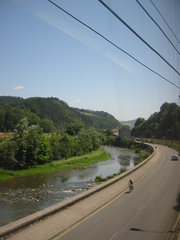Basque Country
From Wikipedia, the free encyclopedia.
- This article is about the traditional Basque domain. For the Spanish autonomous community, see Basque Country (autonomous community). The French translation Pays Basque applies also to a smaller part.
The Basque Country (Euskal Herria in Basque) straddles the western Pyrenees mountains that define the border between France and Spain, extending down to the coast of the Bay of Biscay. It corresponds more or less with the historical area of the Basque people and language.
Contents |
Geography
According to the Basque tradition, the Basque Country is made up of seven traditional regions. The four regions to the south, form Hegoalde (“south zone”), while the three to the northeast, within France, form Iparralde (“north zone”). The seven regions are:

Southern Basque Country
- Álava (Araba in Basque)
- Guipúzcoa (Gipuzkoa in Basque)
- Navarre (Nafarroa in Basque, Navarra in Spanish)
- Biscay (Bizkaia in Basque, Vizcaya in Spanish)
Northern Basque Country
- Lower Navarre (Behe Nafarroa in Basque, Basse-Navarre in French)
- Labourd (Lapurdi in Basque)
- Soule (Zuberoa in Basque)
Today's borders
Today, the Southern Basque Country falls within the Spanish autonomous communities of the Basque Country and Navarra-Navarre-Nafarroa, and the Northern Basque country forms part of the French département of Pyrénées Atlantiques.
History
See the article on the Basque people for their full history.
The Kingdom of Navarre was during a very short period of time the only political entity to encompass the Basque Country on both sides of the Pyrenees. The kingdom reached its greatest size under Sancho III of Navarre (c. 985–1035). It incorporated most Basque-speaking lands, among others, but was divided repeatedly after his death. In 1512, the troops of Ferdinand II of Aragon took the Southern part, but Basse-Navarre, north of the Pyrenees remained independent until 1620 when it was incorporated into France, with which it had been in personal union since 1589, when the King of Navarre inherited the French throne.
Since the time of Sancho III, there has been no single government over all seven territories. Basque nationalism emerged in the 19th century as the aspiration for such a nation state. In the 1980s, the Spanish state devolved into autonomous communities, of which the Spanish Basque Country became the Basque Country. Against the wishes of Basque nationalists but favoring the wishes of most the population of Navarra, Navarre established itself separately with little cultural collaboration. More recently, cross-border meetings among the Basque regions have been sponsored by the Atlantic Arc Commission of the European Union.
See also
- Basque Country (Travel guide)
- Basque Country (autonomous community)
- Basque people
- Basque Mythology
- List of not fully sovereign nations
|
|
|
|---|---|
| Hegoalde: Gipuzkoa | Araba | Bizkaia | Nafarroa Iparralde: Lapurdi | Nafarroa Beherea | Zuberoa |
|




